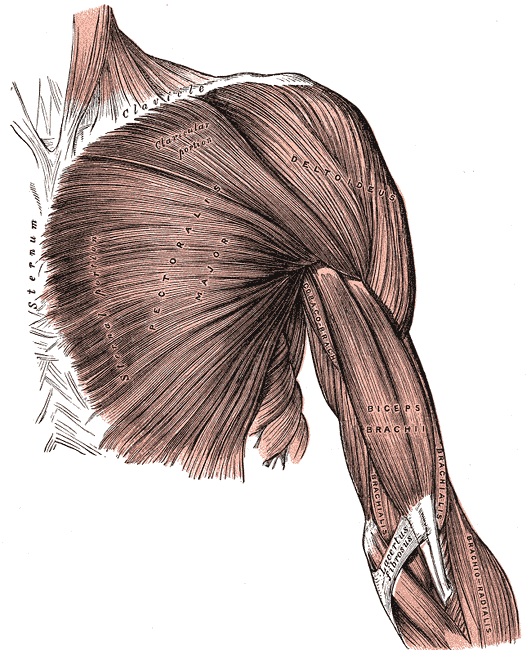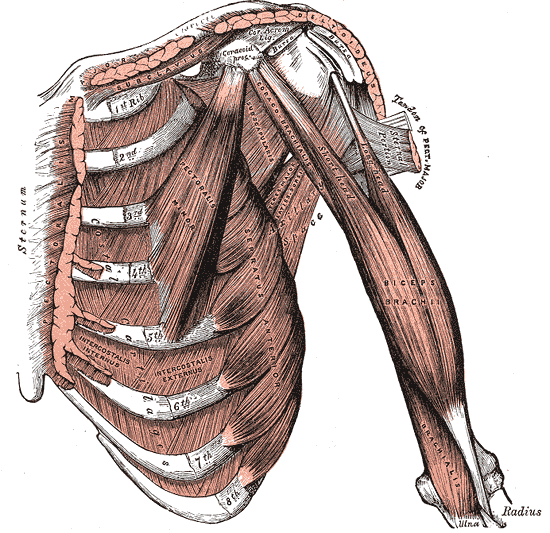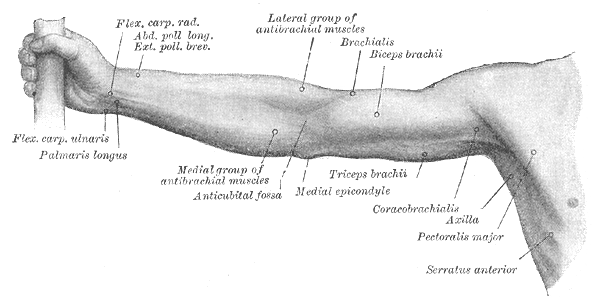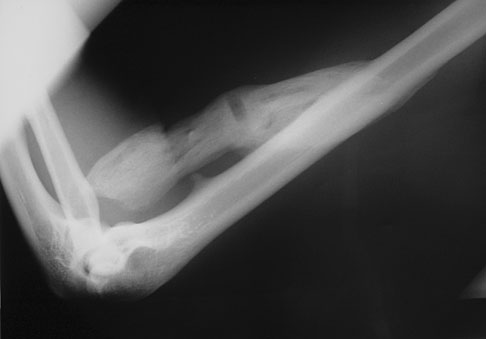[1]
Ilayperuma I, Uluwitiya SM, Nanayakkara BG, Palahepitiya KN. Re-visiting the brachialis muscle: morphology, morphometry, gender diversity, and innervation. Surgical and radiologic anatomy : SRA. 2019 Apr:41(4):393-400. doi: 10.1007/s00276-019-02182-2. Epub 2019 Feb 28
[PubMed PMID: 30820647]
[2]
Palazzi S,Palazzi JL,Caceres JP, Neurotization with the brachialis muscle motor nerve. Microsurgery. 2006;
[PubMed PMID: 16685741]
[3]
Leonello DT,Galley IJ,Bain GI,Carter CD, Brachialis muscle anatomy. A study in cadavers. The Journal of bone and joint surgery. American volume. 2007 Jun;
[PubMed PMID: 17545433]
[4]
Endo T, Molecular mechanisms of skeletal muscle development, regeneration, and osteogenic conversion. Bone. 2015 Nov;
[PubMed PMID: 26453493]
[6]
Zeller R,López-Ríos J,Zuniga A, Vertebrate limb bud development: moving towards integrative analysis of organogenesis. Nature reviews. Genetics. 2009 Dec;
[PubMed PMID: 19920852]
[7]
Ma CX,Pan WR,Liu ZA,Zeng FQ,Qiu ZQ,Liu MY, Deep lymphatic anatomy of the upper limb: An anatomical study and clinical implications. Annals of anatomy = Anatomischer Anzeiger : official organ of the Anatomische Gesellschaft. 2019 May;
[PubMed PMID: 30716466]
Level 2 (mid-level) evidence
[8]
Kusztal M,Weyde W,Letachowicz K,Gołebiowski T,Letachowicz W, Anatomical vascular variations and practical implications for access creation on the upper limb. The journal of vascular access. 2014;
[PubMed PMID: 24817459]
[9]
Rodríguez-Niedenführ M,Vázquez T,Nearn L,Ferreira B,Parkin I,Sañudo JR, Variations of the arterial pattern in the upper limb revisited: a morphological and statistical study, with a review of the literature. Journal of anatomy. 2001 Nov;
[PubMed PMID: 11760886]
[10]
Haładaj R,Wysiadecki G,Dudkiewicz Z,Polguj M,Topol M, The High Origin of the Radial Artery (Brachioradial Artery): Its Anatomical Variations, Clinical Significance, and Contribution to the Blood Supply of the Hand. BioMed research international. 2018;
[PubMed PMID: 29992133]
[11]
Frazer EA,Hobson M,McDonald SW, The distribution of the radial and musculocutaneous nerves in the brachialis muscle. Clinical anatomy (New York, N.Y.). 2007 Oct;
[PubMed PMID: 17854055]
[12]
Pacha Vicente D,Forcada Calvet P,Carrera Burgaya A,Llusá Pérez M, Innervation of biceps brachii and brachialis: Anatomical and surgical approach. Clinical anatomy (New York, N.Y.). 2005 Apr
[PubMed PMID: 15768419]
[13]
Won SY,Cho YH,Choi YJ,Favero V,Woo HS,Chang KY,Hu KS,Kim HJ, Intramuscular innervation patterns of the brachialis muscle. Clinical anatomy (New York, N.Y.). 2015 Jan
[PubMed PMID: 24596238]
[14]
Bhardwaj P,Venkatramani H,Sivakumar B,Graham DJ,Vigneswaran V,Sabapathy SR, Anatomic Variations of the Musculocutaneous Nerve and Clinical Implications for Restoration of Elbow Flexion. The Journal of hand surgery. 2022 Oct;
[PubMed PMID: 36064510]
[15]
Thieffry C,Chenin L,Foulon P,Havet E,Peltier J, Microsurgical anatomy of branches of musculocutaneous nerve: clinical relevance for spastic elbow surgery. Surgical and radiologic anatomy : SRA. 2017 Jul
[PubMed PMID: 28039506]
[16]
Pai MM,Nayak SR,Vadgaonkar R,Ranade AV,Prabhu LV,Thomas M,Sugavasi R, Accessory brachialis muscle: a case report. Morphologie : bulletin de l
[PubMed PMID: 18487066]
Level 3 (low-level) evidence
[17]
Loukas M,Louis RG Jr,South G,Alsheik E,Christopherson C, A case of an accessory brachialis muscle. Clinical anatomy (New York, N.Y.). 2006 Sep;
[PubMed PMID: 16917824]
Level 3 (low-level) evidence
[18]
Vadgaonkar R,Rai R,Ranade AV,Nayak SR,Pai MM,Lakshmi R, A case report on accessory brachialis muscle. Romanian journal of morphology and embryology = Revue roumaine de morphologie et embryologie. 2008;
[PubMed PMID: 19050812]
Level 3 (low-level) evidence
[19]
Koudstaal MJ,De Ridder VA,De Lange S,Ulrich C, Pediatric supracondylar humerus fractures: the anterior approach. Journal of orthopaedic trauma. 2002 Jul;
[PubMed PMID: 12142829]
[20]
Cheng JC,Shen WY, Limb fracture pattern in different pediatric age groups: a study of 3,350 children. Journal of orthopaedic trauma. 1993;
[PubMed PMID: 8433194]
[21]
Mills WJ,Hanel DP,Smith DG, Lateral approach to the humeral shaft: an alternative approach for fracture treatment. Journal of orthopaedic trauma. 1996;
[PubMed PMID: 8932665]
[22]
Curry EJ,Cusano A,Elattar O,Bogart A,Murakami A,Li X, Brachialis Muscle Tendon Rupture of the Distal Ulnar Attachment in a Competitive Weight Lifter. Orthopedics. 2019 May 1;
[PubMed PMID: 30810756]
[23]
Costa JH,Marques TP, Traumatic rupture of the brachialis muscle in a 52-year-old man. BMJ case reports. 2015 Jul 10;
[PubMed PMID: 26163553]
Level 3 (low-level) evidence
[24]
Schönberger TJ,Ernst MF, A brachialis muscle rupture diagnosed by ultrasound; case report. International journal of emergency medicine. 2011 Jul 26;
[PubMed PMID: 21791098]
Level 3 (low-level) evidence
[25]
Van den Berghe GR,Queenan JF,Murphy DA, Isolated rupture of the brachialis : a case report. The Journal of bone and joint surgery. American volume. 2001 Jul;
[PubMed PMID: 11451979]
Level 3 (low-level) evidence
[26]
Bertelli JA,Ghizoni MF, Brachialis muscle transfer to reconstruct finger flexion or wrist extension in brachial plexus palsy. The Journal of hand surgery. 2006 Feb;
[PubMed PMID: 16473677]
[27]
Koehler SM,Meier KM,Lovy A,Fitzpatrick D,Kim J,Hausman MR, Brachialis syndrome: a rare consequence of patient positioning causing postoperative median neuropathy. Journal of shoulder and elbow surgery. 2016 May
[PubMed PMID: 26948003]
[28]
Saad A,Azzopardi C,Patel A,Davies AM,Botchu R, Myositis ossificans revisited - The largest reported case series. Journal of clinical orthopaedics and trauma. 2021 Jun
[PubMed PMID: 33816108]
Level 2 (mid-level) evidence
[29]
Orava S,Sinikumpu JJ,Sarimo J,Lempainen L,Mann G,Hetsroni I, Surgical excision of symptomatic mature posttraumatic myositis ossificans: characteristics and outcomes in 32 athletes. Knee surgery, sports traumatology, arthroscopy : official journal of the ESSKA. 2017 Dec;
[PubMed PMID: 28780628]
[30]
Pakos EE,Pitouli EJ,Tsekeris PG,Papathanasopoulou V,Stafilas K,Xenakis TH, Prevention of heterotopic ossification in high-risk patients with total hip arthroplasty: the experience of a combined therapeutic protocol. International orthopaedics. 2006 Apr
[PubMed PMID: 16482442]
[31]
Golub IJ,Garcia RA,Wittig JC, A 15-Year-Old Male Baseball Player With a Mass in the Brachialis Muscle. Orthopedics. 2016 May 1
[PubMed PMID: 27045482]
[32]
McLoughlin E,Iqbal A,Shamji R,James SL,Botchu R, Brachialis tendinopathy: a rare cause of antecubital pain and ultrasound-guided injection technique. Journal of ultrasound. 2021 Sep
[PubMed PMID: 31006087]




